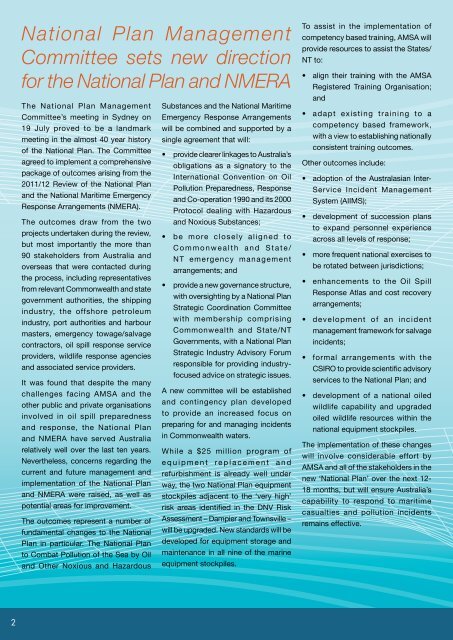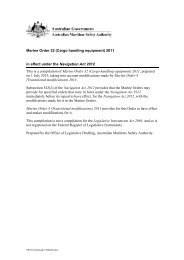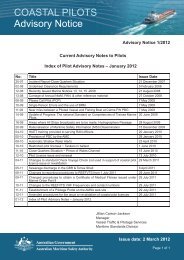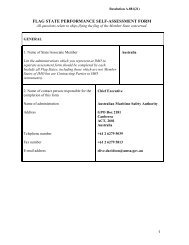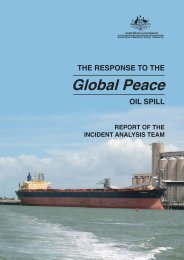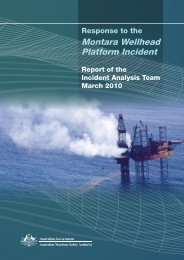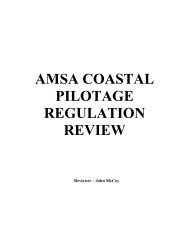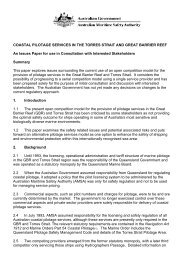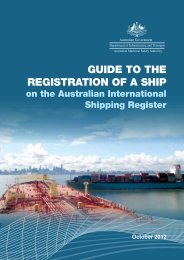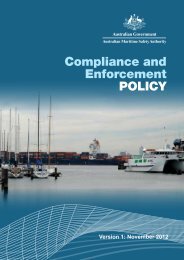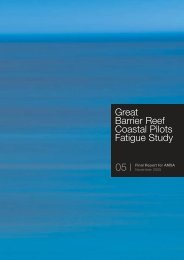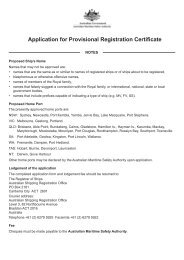Drifting vessel MV ID Integrity - Australian Maritime Safety Authority
Drifting vessel MV ID Integrity - Australian Maritime Safety Authority
Drifting vessel MV ID Integrity - Australian Maritime Safety Authority
Create successful ePaper yourself
Turn your PDF publications into a flip-book with our unique Google optimized e-Paper software.
National Plan Management<br />
Committee sets new direction<br />
for the National Plan and NMERA<br />
The National Plan Management<br />
Committee’s meeting in Sydney on<br />
19 July proved to be a landmark<br />
meeting in the almost 40 year history<br />
of the National Plan. The Committee<br />
agreed to implement a comprehensive<br />
package of outcomes arising from the<br />
2011/12 Review of the National Plan<br />
and the National <strong>Maritime</strong> Emergency<br />
Response Arrangements (NMERA).<br />
The outcomes draw from the two<br />
projects undertaken during the review,<br />
but most importantly the more than<br />
90 stakeholders from Australia and<br />
overseas that were contacted during<br />
the process, including representatives<br />
from relevant Commonwealth and state<br />
government authorities, the shipping<br />
industry, the offshore petroleum<br />
industry, port authorities and harbour<br />
masters, emergency towage/salvage<br />
contractors, oil spill response service<br />
providers, wildlife response agencies<br />
and associated service providers.<br />
It was found that despite the many<br />
challenges facing AMSA and the<br />
other public and private organisations<br />
involved in oil spill preparedness<br />
and response, the National Plan<br />
and NMERA have served Australia<br />
relatively well over the last ten years.<br />
Nevertheless, concerns regarding the<br />
current and future management and<br />
implementation of the National Plan<br />
and NMERA were raised, as well as<br />
potential areas for improvement.<br />
The outcomes represent a number of<br />
fundamental changes to the National<br />
Plan in particular. The National Plan<br />
to Combat Pollution of the Sea by Oil<br />
and Other Noxious and Hazardous<br />
Substances and the National <strong>Maritime</strong><br />
Emergency Response Arrangements<br />
will be combined and supported by a<br />
single agreement that will:<br />
• provide clearer linkages to Australia’s<br />
obligations as a signatory to the<br />
International Convention on Oil<br />
Pollution Preparedness, Response<br />
and Co-operation 1990 and its 2000<br />
Protocol dealing with Hazardous<br />
and Noxious Substances;<br />
• be more closely aligned to<br />
Commonwealth and State/<br />
NT emergency management<br />
arrangements; and<br />
• provide a new governance structure,<br />
with oversighting by a National Plan<br />
Strategic Coordination Committee<br />
with membership comprising<br />
Commonwealth and State/NT<br />
Governments, with a National Plan<br />
Strategic Industry Advisory Forum<br />
responsible for providing industryfocused<br />
advice on strategic issues.<br />
A new committee will be established<br />
and contingency plan developed<br />
to provide an increased focus on<br />
preparing for and managing incidents<br />
in Commonwealth waters.<br />
While a $25 million program of<br />
equipment replacement and<br />
refurbishment is already well under<br />
way, the two National Plan equipment<br />
stockpiles adjacent to the ‘very high’<br />
risk areas identified in the DNV Risk<br />
Assessment – Dampier and Townsville –<br />
will be upgraded. New standards will be<br />
developed for equipment storage and<br />
maintenance in all nine of the marine<br />
equipment stockpiles.<br />
To assist in the implementation of<br />
competency based training, AMSA will<br />
provide resources to assist the States/<br />
NT to:<br />
• align their training with the AMSA<br />
Registered Training Organisation;<br />
and<br />
• adapt existing training to a<br />
competency based framework,<br />
with a view to establishing nationally<br />
consistent training outcomes.<br />
Other outcomes include:<br />
• adoption of the Australasian Inter-<br />
Service Incident Management<br />
System (AIIMS);<br />
• development of succession plans<br />
to expand personnel experience<br />
across all levels of response;<br />
• more frequent national exercises to<br />
be rotated between jurisdictions;<br />
• enhancements to the Oil Spill<br />
Response Atlas and cost recovery<br />
arrangements;<br />
• development of an incident<br />
management framework for salvage<br />
incidents;<br />
• formal arrangements with the<br />
CSIRO to provide scientific advisory<br />
services to the National Plan; and<br />
• development of a national oiled<br />
wildlife capability and upgraded<br />
oiled wildlife resources within the<br />
national equipment stockpiles.<br />
The implementation of these changes<br />
will involve considerable effort by<br />
AMSA and all of the stakeholders in the<br />
new ‘National Plan’ over the next 12-<br />
18 months, but will ensure Australia’s<br />
capability to respond to maritime<br />
casualties and pollution incidents<br />
remains effective.<br />
2


